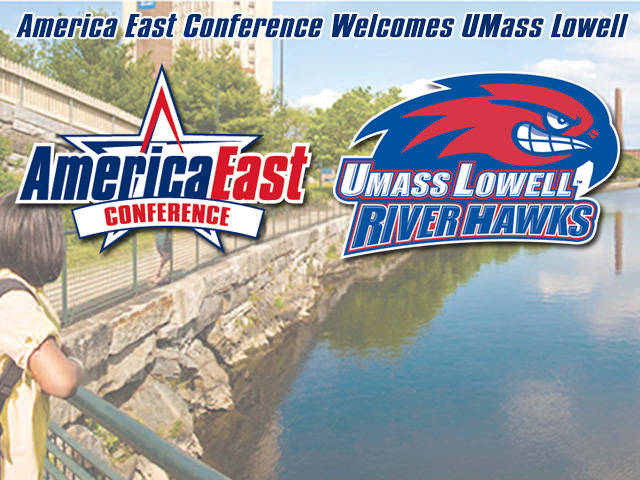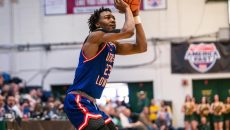In many ways, UMass Lowell has exceeded expectations as its transition to Division I wanes. (Courtesy of America East)
Marlon Pitter
Connector Editor
With every road trip comes a map. With every long-term goal comes a plan on how to achieve it. With the final weeks winding down on UMass Lowell’s transition to becoming a full NCAA Division I member institution, Director of Athletics Dana Skinner sees the university right where it needs to be heading into an era of increased growth and prosperity.
While the university has opened 13 new buildings since 2009 and is set to open the newly-acquired Perkins Complex as a residence hall in fall 2017, the foundation for UMass Lowell’s Division I era has also been under construction over the last four years.
The four years of the River Hawks’ ascension to Division I competition have featured a myriad of varying results among the competing programs, who left Division II’s Northeast-10 Conference to compete in America East.
The men’s cross country team led the way to UMass Lowell’s first conference championship in the Division I era, winning an America East title in fall 2015, while men’s soccer captured a regular season conference title of its own the following year.
On the other end of the spectrum, both volleyball and women’s lacrosse opened their Division I eras with winless seasons in fall 2013 and spring 2015, respectively, but the latter team has since bounced back to climb above .500 this year.
While the rest of the teams have fallen somewhere in between competitively, Skinner said the jump to competing in Division I had less to do with athletics and more to do with academic association with many of the schools in America East.
‘You are who your friends are’
Division I is an athletic designation, but often schools in conferences have similar academic profiles—think Ivy League with its liberal arts schools, the Big Ten with its large mostly mid-Western state schools or the Big East with its Catholic university members.
“First and foremost,” Skinner said, the university’s goal was “to affiliate with our peer institutions, public research universities in our geographic footprint.” Competing on and off the playing surface with University of New Hampshire, University of Vermont, Stony Brook University and more, Skinner said UMass Lowell is “in the right place.”
However, according to Skinner, UMass Lowell found itself in Division I earlier than expected. When the university decided to join America East in 2013, the university had recently begun evaluating its Division II athletic program with a five-year plan to increase its funding and then “explore Division I.”’
Shortly after UMass Lowell initiated its self-study, Boston University – now a member of the Patriot League – announced its departure from America East, leaving a viable and geographically desirable mid-major conference slot immediately open for the River Hawks.
“The question was, ‘Do you wait the five years to elevate your programs, or do you just take advantage of the opportunity that was right in front of you?’” Skinner said. “We decided that you never know if there was going to be another opportunity to go to Division I, so we decided to jump right in with both feet.”
From the conference’s perspective, America East Commissioner Amy Huchthausen said the league was not in a rush to replace Boston University and would have been content with eight schools. Instead, UMass Lowell was the perfect mix of geography, academic and athletic prowess that fit the identity of the America East conference.
“If a school like UMass Lowell hadn’t appeared, we wouldn’t have added anyone,” said Huchthausen. “They were the right fit for America East, not just filling a spot.”
The jump has resonated with a student body already excited about its Division I hockey squad. Senior business major Tim Fougere said he is happy with the attention the leap to Division I gives the university regardless of the timing.
“It’s given off more a prestigious feel for the school knowing that we’re a D-I team across the board,” he said. “It definitely brings this sense of accomplishment that the school has.”
Long-term investment
The benefits of immediately elevating and beginning the transition process were met with equally substantial drawbacks to surpass, mainly financial hurdles. UMass Lowell operated on a budget suitable for its Division II status in 2013 but was left shorthanded by forgoing its five-year fundraising plan, said Skinner.
“We hadn’t risen to the highest level of funding for Division II,” he said, “so we sort of entered Division I as a Division II program.”
The River Hawks, instead, have had to compete and steadily increase their athletic budget on the fly, affecting everything from recruiting and scholarship offers to team travel and coach salaries.
Until UMass Lowell officially completes its transition, the university will also miss out on revenue sharing from the NCAA, Skinner said, which can be instrumental in kickstarting the athletic program.
Without the scholarships and resources that its conference rivals possess, UMass Lowell has still been able to bring in and develop talented players to compete through the transition. Star players like men’s basketball forward Jahad Thomas, men’s soccer forward Wuilito Fernandes, and women’s basketball guards Shannon Samuels and Jasmine McRoy have helped the River Hawks keep pace early in the teams’ Division I eras.
As full Division I membership and postseason eligibility approach for UMass Lowell, however, Skinner said the teams should be able to recruit “difference makers” who would have otherwise gone elsewhere to have the chance to compete for championships.
“Those individuals that can make the kind of plays you need to get over the hump, they’re heavily recruited,” he said, “and in order to convince those student-athletes to come to your institution, they need to know that they’re going to have an opportunity to be on the highest stage.”
Huchthausen said she commends UMass Lowell for meeting America East expectations with so few resources to begin its transition. The university upgraded its field hockey playing surface, Wicked Blue Field, in time for its first season of Division I competition, added men’s and women’s lacrosse in the second year of the transition and has rounded the out the final year by meeting the conference’s initiatives to stream home basketball games on ESPN3.
“It wasn’t just talk,” Huchthausen said. “[UMass Lowell is] committed to action and being a successful Division I program and not just thankful they got here.”
‘#OurHouseRules’
To Skinner, hosting big games is just as important as signing big names when it comes to cultivating a Division I fan base throughout and beyond the transition. Moving forward, every game matters as each win can put the River Hawks one victory closer to hosting America East playoff games.
“Those are incredibly important games to host on your campus to build up the sort of community interest and campus interest that we’re all looking for,” he said.
Starting in the 2014-15 season, America East changed the men’s basketball tournament format to allow higher seeds to host games instead of playing at one campus site until the championship game and the moving to the campus of the highest remaining seed. The conference opened the men’s and women’s basketball seasons that year with the #OurHouseRules social media campaign to increase visibility and attendance.
For men’s basketball head coach Pat Duquette, the opportunity to host a playoff game is essential in gaining support for the basketball team coming out of the transition.
“Most kids are aware of [March Madness], and they get excited about it. So I think basketball can be a sport that the entire student body will support and get excited about. Especially once we become NCAA-eligible,” said Duquette. “And if we can get to the point where we can host a game in the [America East] tournament to try to get to the NCAAs, I think the student body will really embrace the program and support us.”
While men’s basketball will have to earn the right to host a playoff game, UMass Lowell will be the host campus of the America East Field Hockey Championship tournament this fall. UMass Lowell field hockey will only be in its third year of Division I postseason eligibility, but head coach Shannon Hlebichuk expects continued support for the program since its Division II era coming out of the transition.
“I think that we have an established fan base because of our previous success,” Hlebichuk said. “The Merrimack Valley has really bought in to field hockey, which is always great. We have local clubs, high schools and coaches that have supported us and have been excited to watch our transition to Division I.”
Title contention
UMass Lowell’s trophy case in Costello boasts championships from the university’s successful Division II era in the Northeast-10 Conference from 2000 to 2013. Even more historic banners, listing tournament appearances dating back several decades, hang above the basketball court.
Now, the challenge for the present-day coaches is to add America East titles and NCAA tournament appearances to an already illustrious athletic history.
For field hockey, arguably UMass Lowell’s most successful Division II program in recent years winning national championships in 2005 and 2010, Hlebichuk has her sights set on an America East championship within the next five years.
“It’s well within our reach,” said Hlebichuk. “Realistically, we should be in the America East tournament every year, and before you know it, we should be winning a championship.”
Likewise, Duquette can see his team competing for the America East crown after finishing in the middle of the conference standings each year during the transition.
“We’ve finished ahead of expectations, so I think there’s a belief within the America East that we can be successful here,” Duquette said. “I think the biggest question for us is ‘Can we get better quicker, and can we crack the top of the league?’ That’s the only thing that’s left for us.”
Huchthausen has high hopes for what the River Hawks can accomplished when they are fully eligible next year.
For her, the only thing left for the River Hawks is to “represent America East in the NCAA [tournament] carrying the America East banner,” which would “crystallize and bring full circle the entire process” of adding them to the conference.
While other teams have not enjoyed all the success of other programs through the transition, Skinner said the move to Division I was the right one and the university is in the perfect position moving forward.
“There are different levels within Division I, and we think we’ve found our place in America East,” said Skinner. “We think we are right where we belong as an institution, as an academic institution and for our athletic programs, and now we’ve just got to persevere.”





Pingback: Let’s get it started! | Four Years Stronger